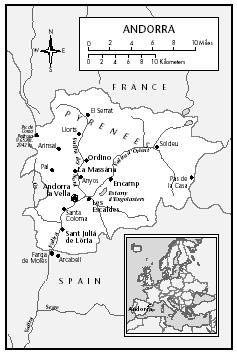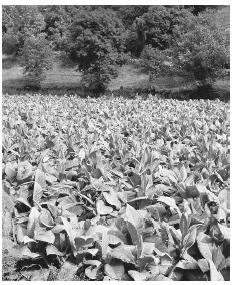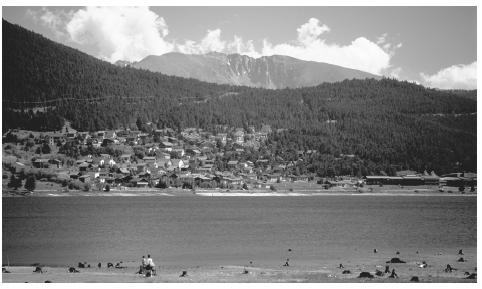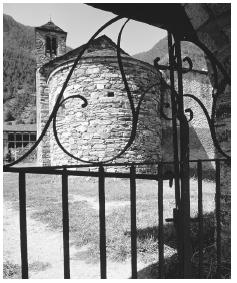Andorra
Culture Name
Andorran
Alternative Names
Principality of Andorra; Andorranos
Orientation
Identification. The first reference to Andorra appears in the writings of the Greek historian Polybius (c. 200–118 B . C . E ), who tells of the military encounter between Andorrans and Carthaginian troops as Hannibal (247–183 B . C . E .) passed through the Pyrenees Mountains en route to Rome. Andorra, historically, was a rural microstate whose population oscillated between four thousand and six thousand inhabitants. In the second half of the twentieth century, as it became a large international commercial center, the nation received larger migratory populations and developed into a multicultural society.
Location and Geography. Andorra has a total land surface of 181 square miles (468 square kilometers) making it slightly less than five times the size of the city of Barcelona. It is situated in the Pyrenees Mountains, bordered by Spain and France. The capital of the nation, Andorra la Vella (Old Andorra), lies in the geographic center of the country, where the two tributaries of the Valira River merge.
Demography. According to the 1998 census, the population stands at 65,877 of whom only 21.7 percent have Andorran citizenship. The rest of the inhabitants are Spanish (42.9 percent), Portuguese (10.7 percent), French (6.7 percent) or other nationalities (6.5 percent). Moreover, more than 7,589 persons, generally children or youth of immigrant families, have no formal citizenship. According to current legislation, foreigners can acquire citizenship after twenty years of residence in the country. Their children, born in Andorra, acquire citizenship at age eighteen.
Linguistic Affiliation. Catalan is the official language of Andorra. It is used throughout public administration, is taught in all schools, and is the language of all road signs. It is also the dominant language in communications media and is the language spoken by the national elites. In commercial signage, Catalan alternates with Spanish and French. Nevertheless, the dominant language of the street is Spanish. The Spanish population represents the largest immigrant community in Andorra and, in addition, the majority of visitors and merchants who come to Andorra are also Spanish. The use of French is limited to populations in the extreme southwest of the country. Portuguese and other languages are limited to private settings.
Symbolism. The Sanctuary of the Virgin of Meritxell, patron of the nation, constitutes the most important religious symbol for Andorrans and is also an attractive spot for tourist visits in the summer. Its thirty Romanesque churches and other treasures of medieval art serve as historical referents as well as emblems of identity.
History and Ethnic Relations
Emergence of the Nation. The origins of Andorra can be situated between the Mesolithic and the Neolithic periods. The archaeological site of Balma Margineda dates back eight thousand years, although full territorial occupation was not achieved until 2000 B . C . E . During the Roman era, Andorra had a stable population. Until the epoch of Arab occupation in the eighth century, Iberian populations mixed with peoples arriving from central Europe. At the beginning of the ninth century, the area was repopulated. The first document that refers to Andorra is the Act of Consecration of the Cathedral of Urgel (839 C . E .). In the eighth and ninth centuries, Andorra belonged to the County of Barcelona, which ceded sovereignty over the valleys of Andorra in 988 to the Episcopal see of Urgel (Spain).

At the end of the thirteenth century, after conflicts between the bishop of Urgel and the count of Foix, a Judicial Decision ( Pareatge ) was signed in 1278 that established the regime of coprinces that remains today. Currently, the two coprinces of Andorra are the president of the French Republic and the bishop of Urgel. Medieval rights over Andorra passed from the count of Foix to the king of Navarre in the fifteenth century, and then to the king of France in the sixteenth century; in the nineteenth century, they passed to the president of the republic.
National Identity. Historically, Andorra has been a protectorate of France and Spain. This is manifest in several ways: (1) the currencies of the nation are the franc and the peseta; (2) the two systems of public education were, until 1982, the French and the Spanish; and (3) the two languages most commonly spoken are French and Spanish, in addition to Catalan. This dualism has been expressed in multiple ways in recent centuries; Andorran factionalism also always has a pro-Spanish front and a pro-French front.
Today, however, both state political powers and Andorran civil society have endeavored to consolidate a national identity that takes as its symbolic referents its medieval past, mythologizing the political peculiarity of the Pareatges. Andorrans also identify themselves as a mountain society and have a special interest in leading sociopolitical and economic movements of the Pyrenean regions. The third pillar of identity is "Catalanness" ( catalanitat ), which it shares with 11 million persons in the northeast of Spain and the southeast of France.
Ethnic Relations. As a culture shaped by transhumant (seasonally transient) shepherds in the past and international merchants in the present, Andorrans are open in character and interethnic relations are not conflictive. Moreover, almost all immigrants come from European nations; hence, cultural differences are not strident.
Urbanism, Architecture, and the Use of Space
Urbanism in the nation reflects both its rural past and its commercial and urban present. While some municipalities such as Canillo and Ordino demonstrate an urbanism typical of any village of the Pyrenean or Alpine high mountains, the urban center formed by Andorra la Vella and Escaldes-Engordany has the face and structure of any typical Western urban commercial center. Other settlements, such as Sant Julia de Loria and Encamp, show a hybrid rural-urban style.
An urban rule also fixes the invented tradition of the "mountain style." This demands that 30 percent of any facade be constructed of stone masonry. Hence large commercial buildings and the majority of urban public buildings show an amalgam of invented tradition and modernity, combining stone with iron and large surfaces of glass. Nevertheless, the building of the national government is of modern design, constructed in concrete and glass. Meanwhile the seat of the Andorran parliament (the General Council) is a noteworthy sixteenth-century edifice, a kind of palace-fortress constructed totally of stone masonry.
The most notable elements of the Andorran patrimony are its thirty Romanesque churches, almost all of them small, built between the ninth and the thirteenth centuries. Some of them conserve frescoes and wood carvings of great value, such as the Virgin of Canolic (which dates to the twelfth century). There are also remains of old castles and medieval fortifications and magnificent examples of rural homesteads. The small Romanesque sanctuary

Almost 60 percent of the Andorran population resides in the capital center. Here, the style of life and uses of space are similar to any other European city. Some immigrant communities (such as the Portuguese and Galicians) have taken over certain public spaces (such as cafés and restaurants) as centers for informal reunions, which convert the spaces into semipublic spaces. Yet, there is no pattern of spatial segregation on the basis of ethnicity, even if there exists a clear territorial division of social class: while workers live in small apartments in center city blocks, elites inhabit luxurious mansions on adjoining hills.
Food and Economy
Food in Daily Life. The diet in Andorra is based on consumption of meat, garden vegetables, and some fish. The most common winter dish, in rural and urban zones, is escudella, a soup of veal, chicken, potatoes, and vegetables. Some immigrant communities have different customs: Portuguese eat more cod and Indians, more vegetarian food. Normally, the midday meal is eaten near the workplace in a restaurant.
Food Customs at Ceremonial Occasions. Many Catholic families still avoid eating meat on Fridays. At the feast of the Virgin of Meritxell, Andorran families often eat outdoors after the solemn midday mass: they consume cold cuts, chicken, and rabbit. The Christmas cycle is also an occasion for the organization of family meals.
Basic Economy. Until about the middle of the twentieth century, the Andorran economy was based on transhumant shepherding and the breeding of cattle and horses. Andorrans also grew some tobacco, while agriculture was oriented to the production of cereals, potatoes, and garden vegetables. Because of the climate, the rocky relief, and the small size of its territory, the country always ran a deficit in agricultural production. Today, due to the commercial orientation of its economy, agriculture has disappeared. Only tobacco survives, with its production tripling since the early 1970s. Coupled with enormous quantities of imported tobacco, this production feeds a strong tobacco industry serving visitors to the country (as well as smuggling). Almost all that Andorrans consume and sell to millions of visitors comes from importation, principally from Spain and France but also from Japan and other countries of the Far East. Yet another extremely important economic activity for the Andorran economy is the banking sector, because of the nation's condition as a "fiscal paradise."
Land Tenure and Property. Most Andorran land is of communal ownership, including the woods and alpine meadows that occupy more than 80 percent of the territory. This situation recurs throughout the Pyrenees, originating in medieval local codes. Private property is found near villages, constituted by homes, rural structures, cultivated fields, and gardens. The exploitation of goods is managed by local administrations ( comuns ) which, in addition, also exercise many functions typical of city halls. The benefits of the exploitation of these goods revert to citizens in the form of infrastructure, equipment, creation of work, scholarships for students, and social service endeavors. Today, four of the seven municipal units ( parroquies ) that form the country have one or more winter resorts, from which they also gain great benefits. The only properties of the state are the courses and banks of the rivers, and roads and highways.
Commercial Activities. Andorra has always had fluid commercial relations with France and Spain, including smuggling. During the Spanish Civil War (1936–1939) and the World War II (1939–1945), the volume of exchanges increased, since Andorra was a platform through which to supply belligerent nations. In addition, the economic isolation of Spain during the dictatorship of Francisco Franco, from 1939 to 1975, favored the commercial activity of Andorra, which supplied equipment, machine parts, vehicles, and other consumer goods. The foundation of the new Andorran economy, however, is retail commerce in major consumer goods, oriented toward buyers in nearby regions of Spain and France.
Major Industries. Andorra's industrial development is extremely limited. Apart from tobacco, the most important industry is construction along with its derivative industries, hospitality industries, and semi-artisanal activities such as jewelry.
Trade. Commerce and tourism are based on the importation of all goods and services from third countries. There are sixty import-export companies handling such goods as gasoline, automobiles, beverages, tobacco, machinery, optical and electronic products, food, clothing, and shoes. Electronic goods come from Japan and other Asian sources, while the rest come from Europe.
Division of Labor. Large Andorran firms belong almost exclusively to Andorran citizens, although there are also some enterprises founded by Spaniards and Frenchmen who have acquired citizenship through their years of residence. Foreigners, Spanish and French, dominated professional positions until recently; high enrollments of university students have fostered a process of nationalization in this occupational level. Employment in construction, transport, commerce, and public services (police and sanitation), like work in hotels, tend to employ resident alien workers depending on their ability and level of instruction.
Social Stratification
Classes and Castes. Class differences in Andorra are quite clear and possess marked characteristics, such as residence. Practically all the original Andorran population belongs to the high or medium-high stratum of society as the first group to arrive in the nation. The rest of the Spanish population is basically salaried, although there are executive groups and small entrepreneurs among them. Most Portuguese are found in less-skilled labor positions, especially in hostelry and construction. The French population comprises bureaucrats and small-scale entrepreneurs in hostelry or commerce.
Symbols of Social Stratification. Apart from evocative differences of residence, other indicators of class difference include fashion. The Andorran elite sport well-known international brands, which contrast with the sobriety of the rest of the society. Automobiles are also a highly visible indicator of consumption. Even though the entire society is motorized, only a minority has access to such luxury cars as Rolls-Royce, Mercedes, Audi, and BMW.
Political Life
Government. Following the 1993 constitution, Andorra is a parliamentary coprincipality, headed by the president of France and the bishop of Urgel. The Andorran parliament (the General Council) includes twenty-eight members, half elected by local constituencies and half by national votes. This system seeks an equilibrium between territory and demography. Elections are held every four years. The winning parliamentary group forms the government.
Leadership and Political Officials. For decades, access to political power in Andorra was linked to two great entrepreneurial families. In the last decade, however, important transformations have emerged from the application of the constitution. There are no real national parties differentiated by ideology and/or in the function of their program of government. Andorran politics are constructed on the basis of influence groups, who defend local and family interests. The elaboration of electoral lists is the result of a complex process of compromise and alliance among client groups. Given the small size of the electorate (some fifteen thousand voters), electoral processes presuppose a face-to-face relation between candidates and electors that is maintained after the election.
Social Problems and Control. The judicial system is constituted at three levels: the Tribunal de Batlles, the Tribunal de Corts, and the Tribunal Superior de Justicia d'Andorra. While all three handle civil and labor affairs, only the first two deal with criminal matters. One might also appeal to a fourth jurisdiction, the Tribunal Constitutional. A corps of judiciary police, distinct from ordinary police, also serves the government. Crime in Andorra is very low. Foreign defendants tend to be extradited to their country of origin. The most frequent crimes are robbery, fraud, and drug trafficking. Labor conflicts,

Social Welfare and Change Programs
Since there is no direct taxation in Andorra, the state has limited resources to maintain the level of opulence that characterizes the country. This means its capacity to implement welfare programs is limited. The principal demands of foreign workers, the most fragile and needy social sector, focus on housing and child care in order to secure the position of female workers. Recently, the government attempted a low-interest credit system through Andorran banks to encourage home ownership, but the results were below expectations. The number of child care centers has grown, but still fails to meet demand.
Nongovernmental Organizations and Other Associations
Andorran organizations are undeveloped, despite the presence of associations in sports, culture, the arts, and business. Unions are not legally accepted, although they exist in clandestine form. All civil associations must be run, legally, by an Andorran citizen. Thus the foreign population has enormous difficulties in constituting associations. The Spanish Embassy helps the Council of Spanish Residents, an association that looks after the needs and interests of that group. Given Andorra's status as a developed nation, foreign nongovernmental organizations are absent.
Gender Roles and Statuses
The Relative Status of Women and Men. Andorran society, with its strong rural origins, maintained a marked segregation on the basis of gender roles until the late twentieth century. All public activity was exercised by men, representing the family. Rapid urbanization, changes in lifestyle, and the commercial orientation of the economy have forced a rapid modification in the economic and work roles of women. Today, their public visibility is total, even if their presence in political spheres remains inferior to that of men, despite consistent progress.
Marriage, Family, and Kinship
Marriage. Marriage is not controlled by any limits except class (and not always by that). Marriages between Andorrans and Spaniards or French are normal.
Domestic Unit. The family remains the basic social unit, more important than the individual, despite the accelerated evolution of Andorran society. Most enterprises and business are organized through the family, distributing functions according to capacities and the level of study of each member. These family groups, following the institution of the familia troncal (stem family), incorporate a married pair and their children.
Inheritance. Formerly, the inheritance system passed nearly all the patrimony to one of the sons: the hereu (heir). Today, this tendency is maintained only at a symbolic level through the transmission of the family home. In the case of rural holdings, only the inheriting son can marry and reside with his wife and children on the family land; however, current family businesses are different. Any child can remain tied to the family business after marriage, although there remains a tendency towards an heir who will follow the father in the operation of the business.
Kin Groups. Networks of kinship are only activated through rituals of sociability for reasons of alliance or political patronage.
Socialization
Child Rearing and Education. Andorran children, as in many other European nations, are placed in child care settings before three years of age, and much of the care and instruction of these children thereafter is done by scholastic institutions. Insufficient relationships between parents and children are noticeable at times. The extended work hours of parents, who often do not return home until 8:30 P.M. , aggravate this tendency. Cases of youth maladjustment, quite frequent in Andorra and affecting all social sectors, are explained by psychologists as stemming from this relationship deficit.
Until 1982, when an Andorran public school system was created, there were only French and Spanish schools. Each parroquia (municipal unit) had a primary school in each system. There were also seven intermediate educational institutions. According to official data, 63 percent of the juvenile population was enrolled in intermediate education in 1999–2000.
Higher Education. Roughly 11 percent of the population between eighteen and twenty-four attends university, especially in Spain and France.

Religion
Religious Beliefs. Even though Andorra lacks a formal religion, Roman Catholicism is hegemonic. One fundamental element of this presence rests on the role of the bishop of Urgel as coprince and, at the same time, head of the Andorran Church. Apart from the Jehovah's Witnesses, there are no public religious alternatives in Andorra.
Rituals and Holy Places. All public ceremonies, including some sessions of the parliament, are accompanied by a Catholic mass. The Andorran festive calendar adapts to the Catholic liturgical calendar, and the nation, like every parroquia, has a patron saint and a collection of religious and lay celebrations.
Medicine and Health Care
The Andorran medical system is guaranteed through a general hospital, situated in the capital, as well as various clinics and private medical centers. Every population center has a family medical service. Alongside official medicine, traditional curing practices based on herbal knowledge also survive. There are no shamanistic practices of curing ( curanderismo ) in Andorra.
Secular Celebrations
In addition to the national festival of the Virgin of Meritxell (8 September), each parroquia has its own patronal festival. Given the commercial orientation of the nation (which remains open for business especially when neighboring nations have holidays), the only formal holidays are Christmas and New Year's Day.
The Arts and Humanities
Support for the Arts. Both the state and communal administrations support artistic formation and creativity. Conservatories of music and art schools are scattered around the nation.
Literature. Andorran literary production does not cross the frontiers of the small country, except in the case of writer A. Morell. There are nonetheless groups of historians and folklorists interested in recovering oral traditions and studying and teaching the nation's history.
Performance Arts. In music, the two great figures of classical music, the Claret brothers, who play violoncello and violin, have gained great prestige throughout Europe.
Bibliography
Armengol, Lídia. Approach to the History of Andorra , 1989.
Baudon de Mony, Charles. "La Vallée d'Andorre et les Êveques d'Urgel au Moyen Age". Revue des Pyrenees et de la France Meridionale , 4: 551–571, 1892.
Bladé, Jean François. The Valley of Andorr , 1882.
Bricall, Josep M., et al. Estructura i perspectives de l'economia andorrana , 1974.
Comas d'Argemir, Dolors, Joan J. Pujadas. Aladradas y guellas; Trabajo, sociedad, y cultura en el Pirineo Aragonés , 1985.
——. Andorra; Un país de frontera , 1997.
De los Ríos, Fernando. Vida e instituciones del pueblo de Andorra. Una supervivencia señorial, 1920.
Deverell, F. H. All Round Spain by Road and Train, with a Short Account of a Visit to Andorra , 1884.
Eyre, Mary. Over the Pyrenees into Spain , 1865.
Llobet, Salvador. El medi i la vida a Andorra , 1986.
Lluelles, M0 Jesús. La transformació econòmica d'Andorra , 1991.
López, E.J., Peruga, and C. Tudel. L'Andorra del segle XIX , 1998.
Newman, B. Round about Andorra , 1928.
Riberaygua, B. Les Valls d'Andorra:. Recull documental , 1946.
Riera, Manel. La llengua catalana a Andorra. Estudi dialectolo`gic dels seus parlars rurals , 1992.
Sacotte, Jean-Charles. "Les Vallées d'Andorre." Notes et Etudes Documentaires , 4087, 2-V-1974.
Sáez, Xavier. "Informe sobre l'economia andorrana, 1995." Andorra, anuari socio-economic, 1996 , 10–67, 1996.
Sandy, Isabelle. Andorre: ou les hommes d'airain , 1923.
Sermet, Jean. Problemas de la frontera hispano-francesa en los Pirineos , 1985.
Taillefer, François. L'Ariège et l'Andorre , 1985.
Viñas, Ramón. Nacionalitat i drets polítics al Principat d'Andorra , 1989.
Violant i Simorra, Ramón. El Pirineo Español , 1949.
—J OAN J. P UJADAS , TRANSLATED BY G ARY W. M C D ONOGH
:)